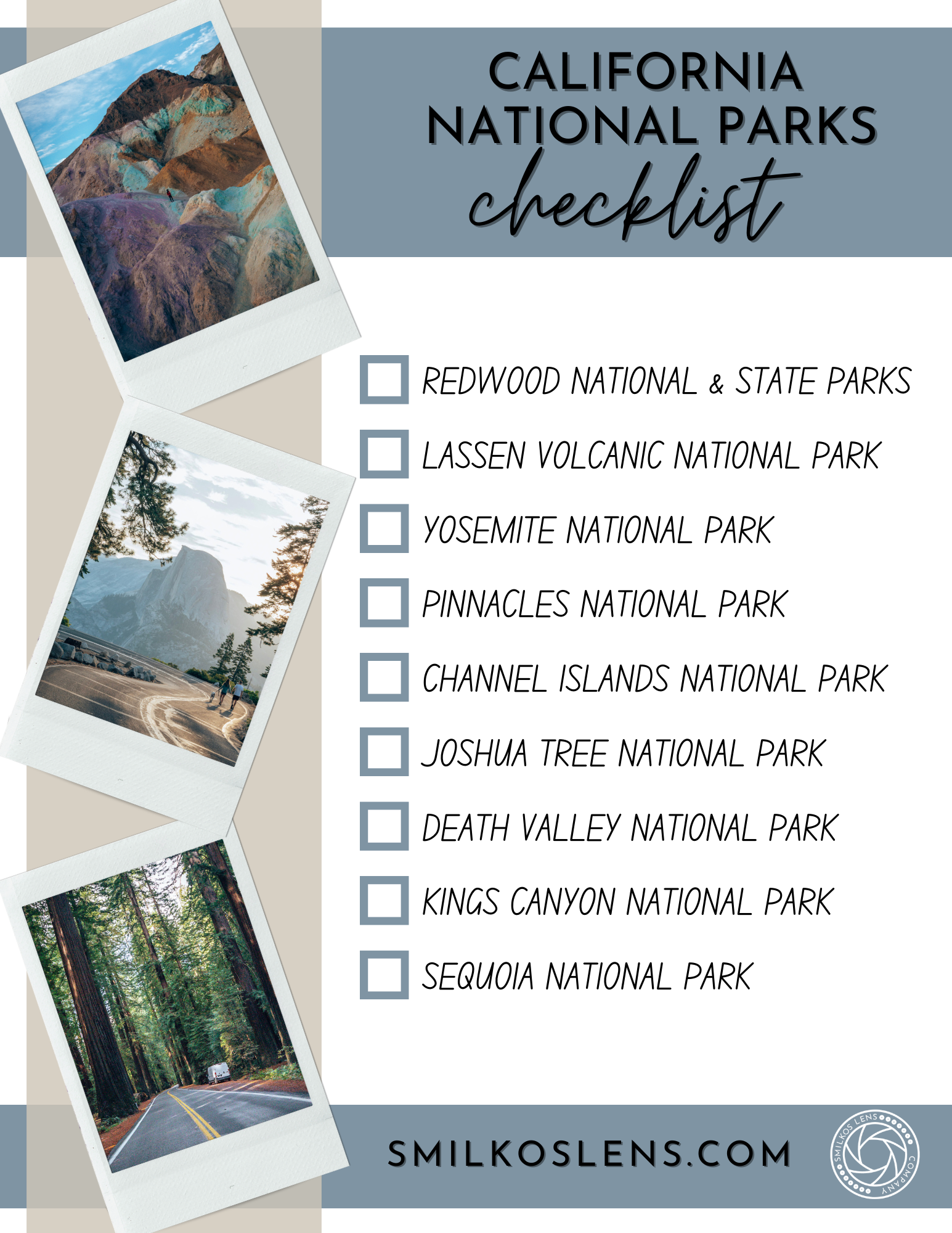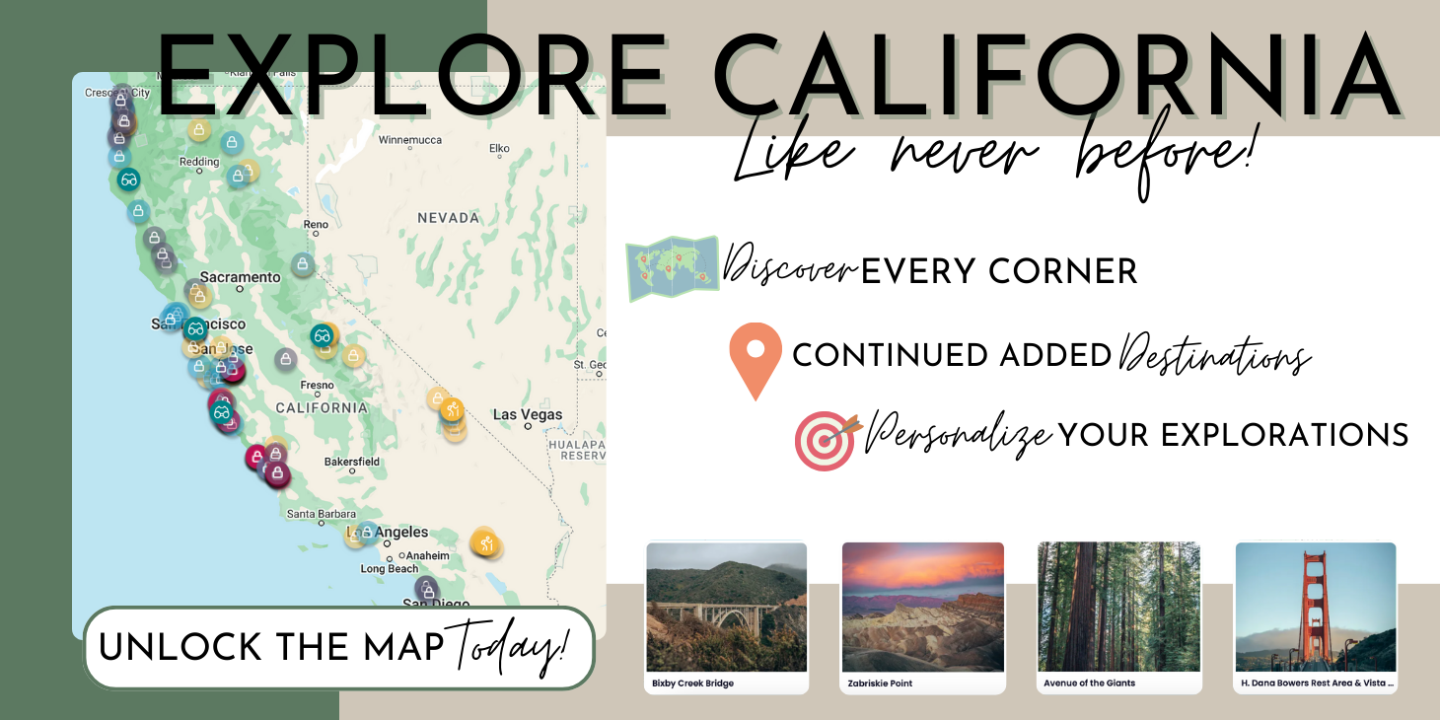California is home to nine out of the 63 U.S. National Parks. That is more than any other state! And due to the size of California, these nine parks offer a wide range of epic landscapes and unbelievable views. These national parks span the state from the Coastal Redwoods in Northern California to the iconic Joshua Trees in Southern California, with islands, volcanoes, and waterfalls in between. And while you may have been lead to believe that California is always sunny and 75ºF – the weather at these parks varies as much as the landscapes themselves.
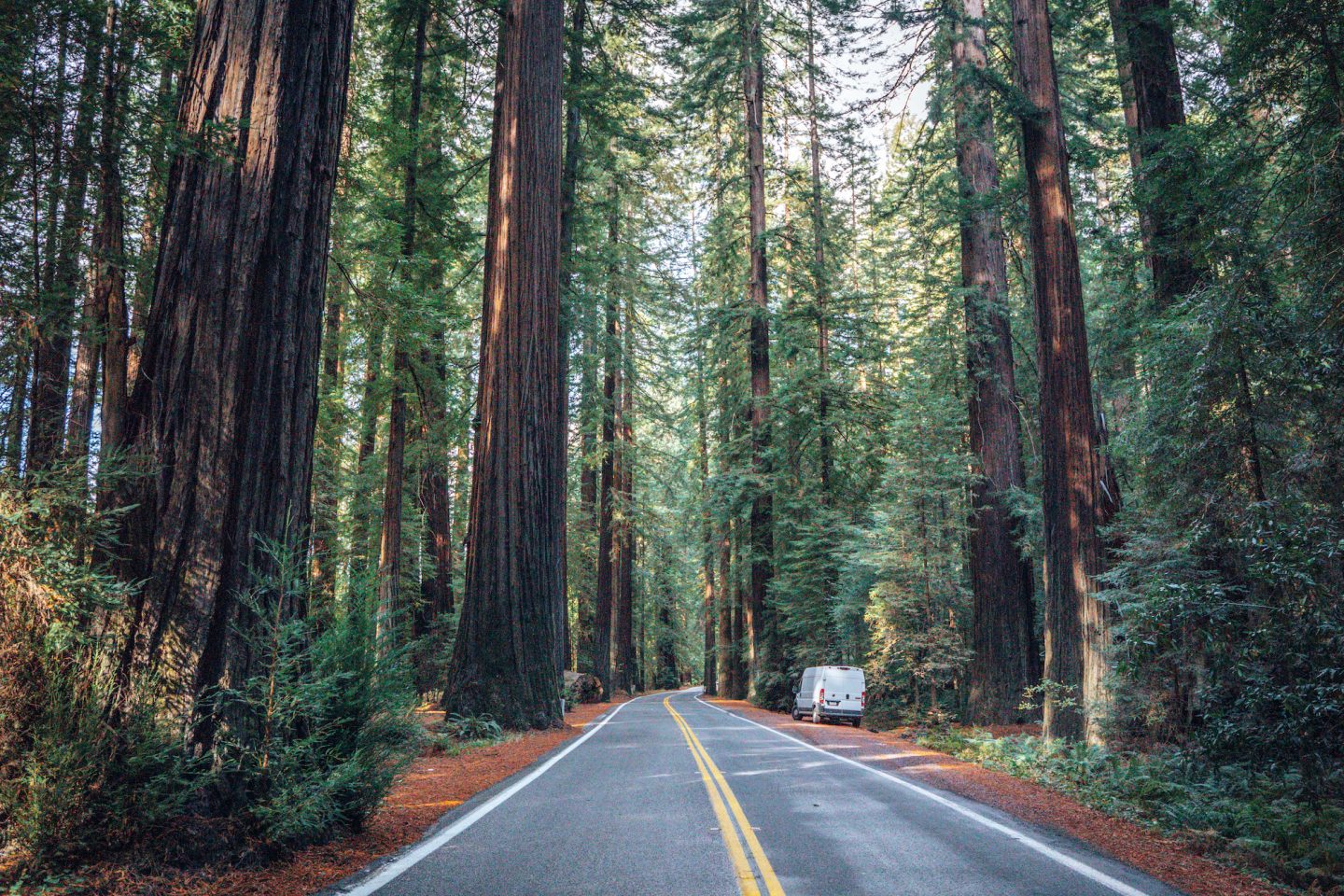
The best time to visit California’s national parks will differ based on what you’re hoping to see. Which means, it’s up to you when the best time to visit is! I know what you’re thinking – “if it’s up to me, why did you write an article?!” Well, we will give you information on popularity, seasonal temperatures, average rainfall and snowfall, and sunrise/sunset times. Armed with this information, you’ll be able to confidently pick the perfect time to plan your California national park visits!
ACROSS ALL CALIFORNIA’S NATIONAL PARKS
California’s national parks offer stunning diversity that you truly need to see to believe. And while each park has unique features – there is one similarity. Weather in national parks can vary greatly from day-to-day as well as at different elevations. It’s wise to come prepared, wear layers, and continue to monitor conditions during your visit.
Keep in mind the temperatures, rainfall, and snowfall are general averages, and the actual conditions can vary from year to year. When planning your visit, be sure to check the current weather conditions and road status for the most accurate information. The number one tip we can recommend for every national park visitor is to check the current conditions. Every national park has a dedicated website where you can find current alerts and conditions. You’ll also find visitor center hours, road closures, trail reconstruction projects, weather warnings, and all pertinent information for planning your upcoming trip. So let’s talk about the best time to visit each of California’s national parks.
REDWOOD NATIONAL & STATE PARKS
Redwood National and State Parks, located along the rugged coastline of northern California, stand as a testament to the majesty and resilience of the ancient redwood trees. These parks, encompassing both federal and state land, are renowned for preserving some of the tallest and oldest trees on Earth, including the iconic Coastal Redwoods. The awe-inspiring heights of these towering giants, which can exceed 350 feet, create a cathedral-like atmosphere beneath their dense canopies.
The 6th most visited national park in California, it does not tend to be crowded. The weather is mild all year so you can visit at any time!
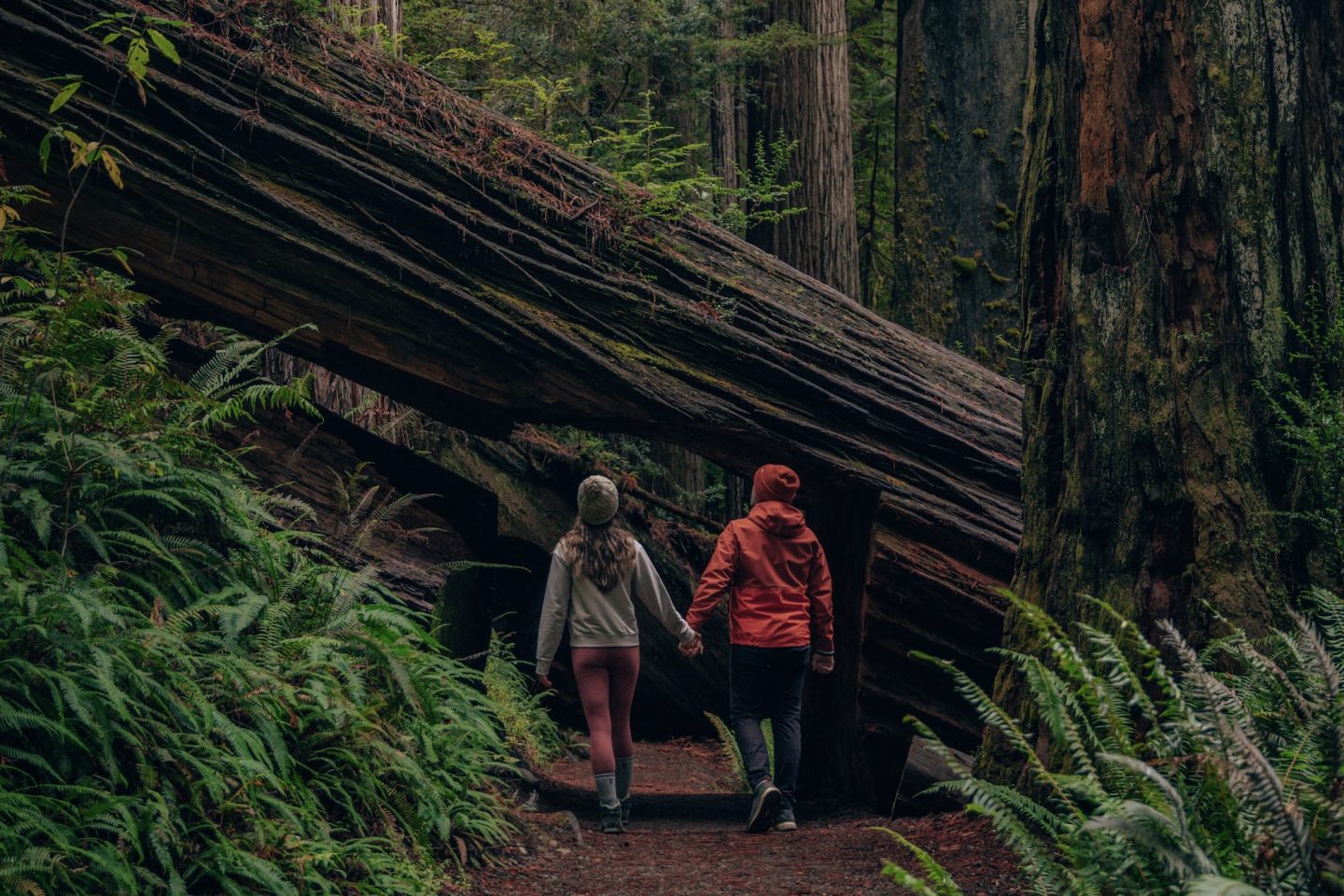
SEASONALITY AT REDWOOD NATIONAL & STATE PARKS
Redwood National and State Parks experience milder and more consistent temperatures due to their coastal location. Visitors should be prepared for cooler and damp weather. Dress in layers and expect to get wet. Summer can be foggy, and winters are cooler with considerable rain. October through April averages 60-80 inches of rain over the region.
Here are approximate average temperatures for each season at various elevations within the parks:
| SPRING | SUMMER | FALL | WINTER | |
| COASTAL | H: 60ºF / L: 40ºF (16ºC / 4ºC) | H: 65ºF / L: 45ºF (18ºC / 7ºC) | H: 60ºF / L: 40ºF (16ºC / 4ºC) | H: 60ºF / L: 45ºF (16ºC / 7ºC) |
| INLAND | H: 65ºF / L: 45ºF (18ºC / 7ºC) | H: 70ºF / L: 50ºF (21ºC / 10ºC) | H: 65ºF / L: 45ºF (18ºC / 7ºC) | H: 60ºF / L: 40ºF (16ºC / 4ºC) |
| RAINFALL (INCHES) | 20-30 | 0-5 | 20-30 | 15-25 |
| SUNRISE/SUNSET | 6:30AM / 7:30PM | 5:30AM / 9:00PM | 7:00AM / 6:30PM | 7:30AM / 5:30PM |
Check out our REDWOOD NATIONAL AND STATE PARKS: HOW TO PLAN YOUR VISIT and 5 MUST-DO ACTIVITIES IN REDWOOD NATIONAL PARK AND STATE PARKS articles for more Redwood inspiration!
LASSEN VOLCANIC NATIONAL PARK
It seems like Lassen Volcanic National Park is one of the least-talked about national parks in California, although not the least visited. Coming it at 7th most-visited in the state, we are here to tell you that is absolutely worth the visit! Lassen Volcanic contains every type of volcano within its borders, along with hydrothermal wonders, painted hills, and mountain peaks. Check out our ULTIMATE GUIDE TO LASSEN VOLCANIC NATIONAL PARK to find out more about planning your trip!
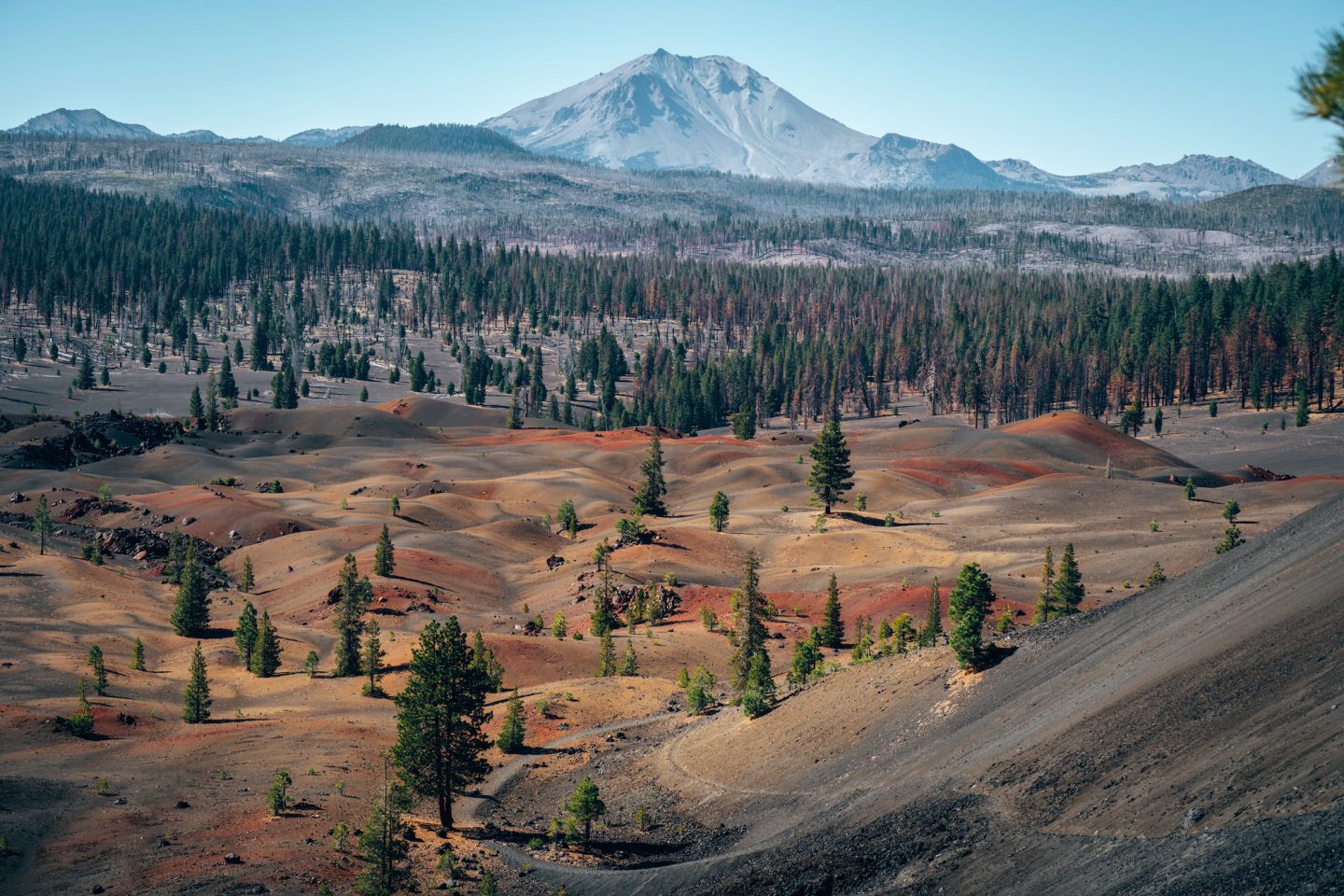
SEASONALITY AT LASSEN VOLCANIC NATIONAL PARK
Lassen Volcanic National Park, located in Northern California, experiences significant temperature variations due to its high elevation. Any place that can be at hot as 90ºF in the summer and then get up to 300 inches of snow in the winter — you know it’s going to be a wild landscape! Here are approximate average temperatures for each season at different elevations within the park:
| SPRING | SUMMER | FALL | WINTER | |
| Foothills Area (3,500 feet) | H: 70ºF / L: 30ºF (21ºC / -1ºC) | H: 90ºF / L: 40ºF (32ºC / 4ºC) | H: 70 / L: 30ºF (21ºC / -1ºC) | H: 50ºF / L: 20ºF (10ºC / -6ºC) |
| Mid-Elevation (6,500-7,500 ft.) | H: 50ºF / L: 20ºF (10ºC / -6ºC) | H: 70ºF / L: 30ºF (21ºC / -1ºC) | H: 50ºF / L: 20ºF (10ºC / -6ºC) | H: 30ºF / L: 0ºF (-1ºC / -17ºC) |
| High-Elevation (above 7,500 ft.) | H: 40ºF / L: 10ºF (4ºC / -12ºC) | H: 60ºF / L: 20ºF (16ºC / -6ºC) | H: 40ºF / L: 10ºF (4ºC / -12ºC) | H: 20ºF / L: -10ºF (-6ºC / -23ºC) |
| RAINFALL (INCHES) | 10-15 | 0-5 | 5-10 | 15-25 |
| SNOWFALL (INCHES) | 20-40 | Minimal to none | 5-20 | 150-300 |
| SUNRISE/SUNSET | 6:30AM / 8:00PM | 5:30AM / 9:00PM | 7:00AM / 7:30PM | 7:30AM / 5:30PM |
YOSEMITE NATIONAL PARK
Yosemite National Park is so iconic, that it’s hard not to fall in love with it. Turning a corner and seeing the towering El Capitan come into view, the vast meadows, powerful waterfalls … it’s a true outdoor lover’s paradise! Yosemite National Park is the MOST visited national park in California with over 3.6 million visitors per year! Summer is the most popular time of year, as well as in February with the viewing of the natural Fire Fall phenomenon. But likely, you won’t ever find a non-crowded time of year to visit this epic national park! If you’re planning to see this park, be sure to read our ULTIMATE GUIDE TO YOSEMITE NATIONAL PARK.
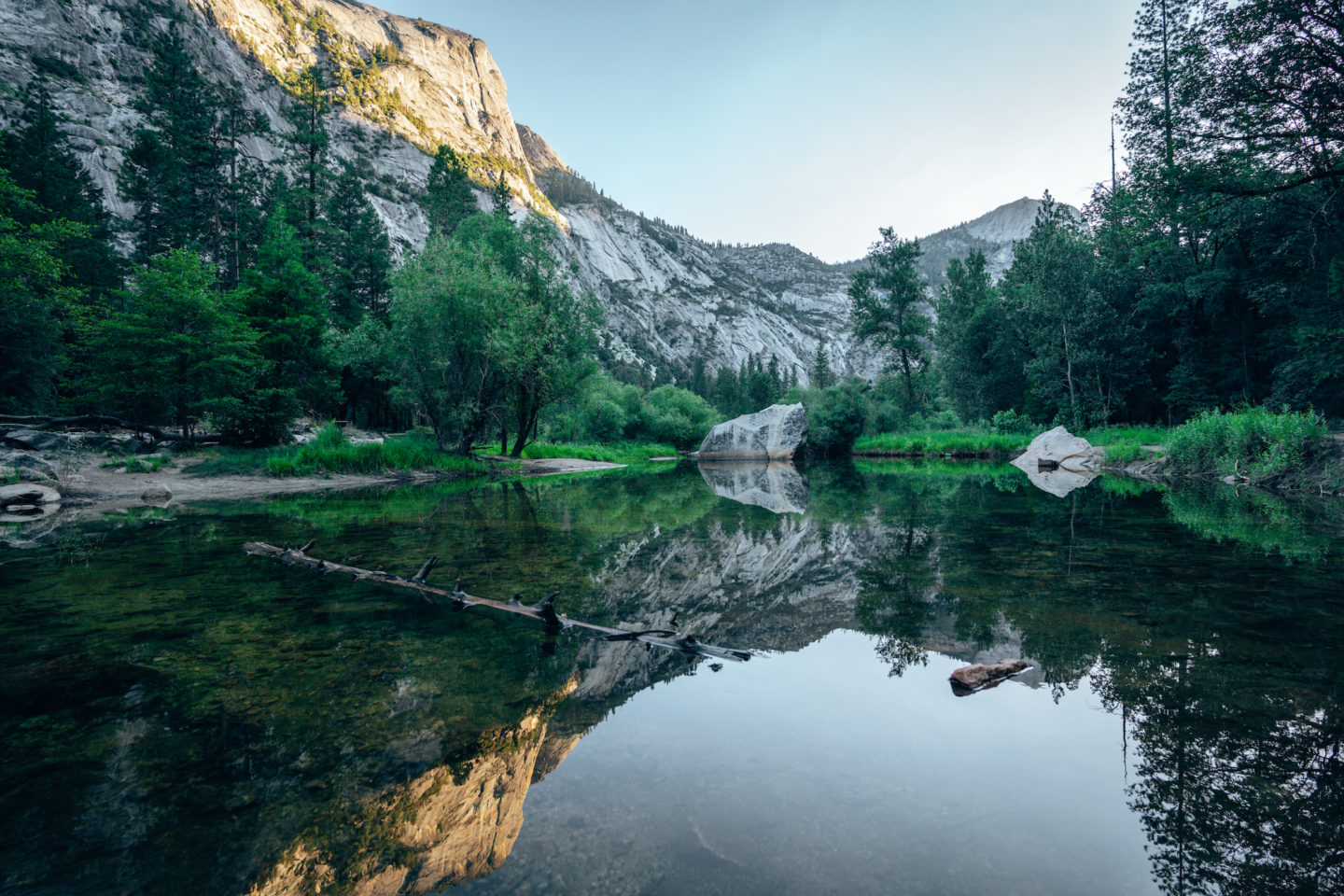
SEASONALITY AT YOSEMITE NATIONAL PARK
Situated in the Sierra Nevada mountains of California, features a wide range of temperatures and conditions due to its diverse elevations. There are annual road and campground closures each winter, as well as unexpected closures due to weather conditions. Here are approximate average temperatures for each season at different elevations within the park:
| SPRING | SUMMER | FALL | WINTER | |
| Yosemite Valley (4,000 feet) | H: 70ºF / L: 30ºF (21ºC / -1ºC) | H: 90ºF / L: 50ºF (32ºC / 10ºC) | H: 80 / L: 40ºF (27ºC / 4ºC) | H: 60ºF / L: 30ºF (16ºC / -1ºC) |
| Mid-Elevation (6,000-7,000 ft.) | H: 60ºF / L: 30ºF (16ºC / -1ºC) | H: 80ºF / L: 40ºF (27ºC / 4ºC) | H: 70ºF / L: 30ºF (21ºC / -1ºC) | H: 50ºF / L: 20ºF (10ºC / -6ºC) |
| High-Sierra (above 7,000 ft.) | H: 50ºF / L: 20ºF (10ºC / -6ºC) | H: 70ºF / L: 30ºF (21ºC / -1ºC) | H: 60ºF / L: 20ºF (16ºC / -6ºC) | H: 40ºF / L: 10ºF (4ºC / -12ºC) |
| RAINFALL (INCHES) | 5-10 | 0-5 | 5-10 | 5-10 |
| SNOWFALL (INCHES) | 5-15 | Minimal to none | 5-10 | 30-60 |
| SUNRISE/SUNSET | 6:00AM / 8:00PM | 5:30AM / 9:00PM | 7:00AM / 7:00PM | 7:30AM / 5:30PM |
PINNACLES NATIONAL PARK
Although Pinnacles National Park is the closest national park to the San Francisco Bay Area and it’s three international airports – Pinnacles National Park is the least visited national park in California! This is good news for you because that means it likely won’t be crowded for your visit! Now, if you’re thinking you’ve never even heard of Pinnacles National Park, then you may want to check out these 10 NATIONAL PARKS IN THE U.S. YOU PROBABLY DIDN’T KNOW EXISTED!
Pinnacles National Park is a great park for hiking and spotting the California Condor! You’ll often see them soaring overhead all while you explore caves, hike trails, rock climb, and camp! (Ok, you might not spot any condors from the caves).
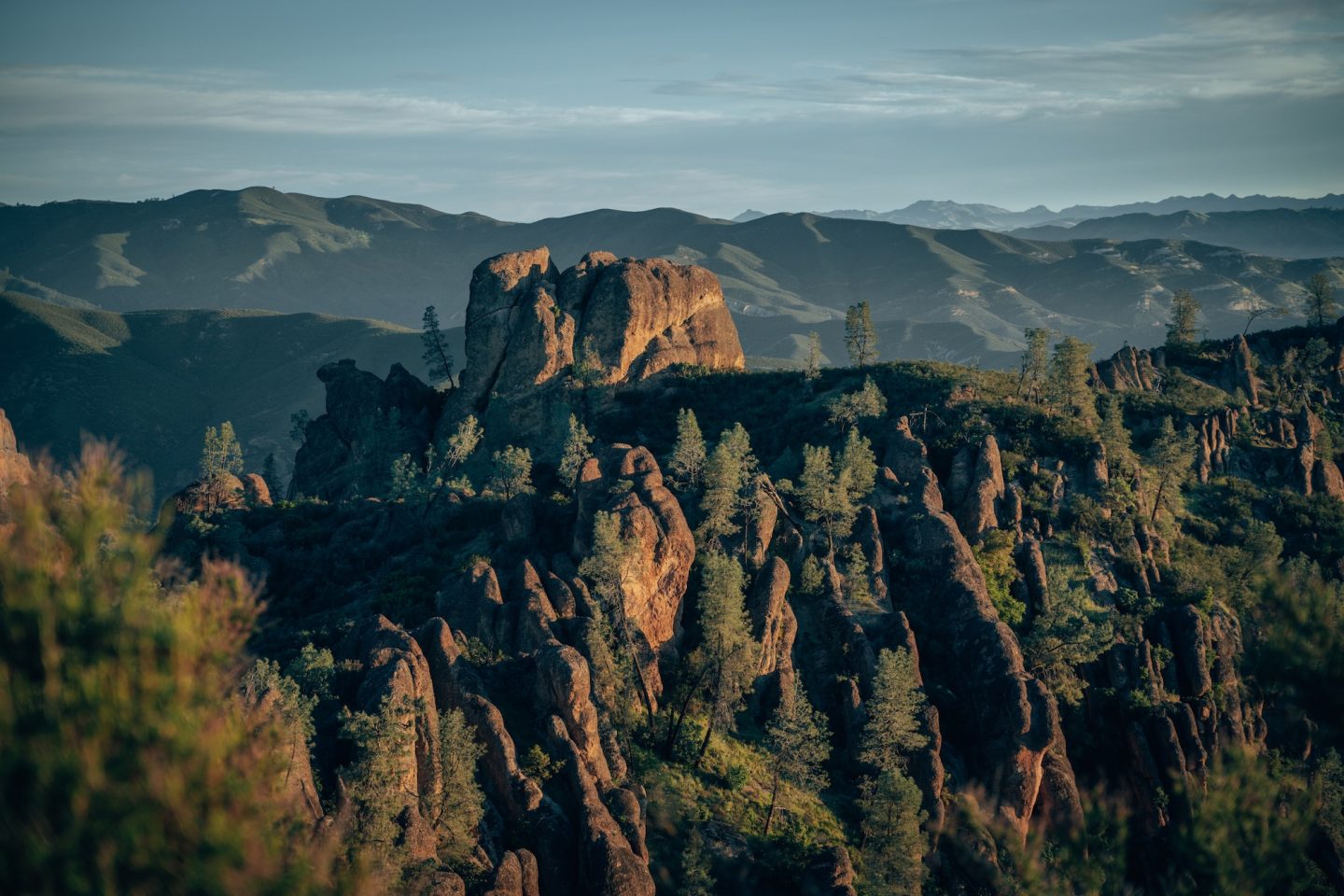
Pinnacles National Park, located in central California, experiences a range of temperatures due to its diverse landscape. Here are approximate average temperatures for each season at different elevations within the park:
SEASONALITY
| SPRING | SUMMER | FALL | WINTER | |
| Low-Elevation (1,000-1,500 ft.) | H: 80ºF / L: 40ºF (27ºC / 4ºC) | H: 100ºF / L: 50ºF (38ºC / 10ºC) | H: 80ºF / L: 40ºF (27ºC / 4ºC) | H: 70ºF / L: 30ºF (21ºC / -1ºC) |
| High Peaks (above 2,500 ft.) | H: 70ºF / L: 30ºF (21ºC / -1ºC) | H: 90ºF / L: 40ºF (32ºC / 4ºC) | H: 70ºF / L: 30ºF (21ºC / -1ºC) | H: 60ºF / L: 20ºF (16ºC / -6ºC) |
| RAINFALL (INCHES) | 5-10 | 0-5 | 5-10 | 5-10 |
| SUNRISE/SUNSET | 6:30AM / 8:00PM | 5:30AM / 9:00PM | 7:00AM / 7:00PM | 7:30AM / 5:30PM |
CHANNEL ISLANDS NATIONAL PARK
It’s hard to know what to expect when visiting Channel Islands National Park when you find out that you’re essentially going to be dropped off on an uninhabited island. Then you board the ferry and start your 1-hour sail to Santa Cruz Island and you are greeted with dolphins and whale sightings, all before you dock! Since there are limited ferries per day, the island cannot get overcrowded. There are five islands that make up the Channel Islands and you can reach some by ferry as well!
If you are able to bring all of your own gear, you can camp overnight on Santa Cruz Island. Or take a day trip and rent kayaks, snorkel, or dive! You can also hike on the trails of the island with stunning ocean views! For all the info and what ferry we booked, check out the ULTIMATE GUIDE TO CHANNEL ISLANDS NATIONAL PARK (SANTA CRUZ ISLAND).
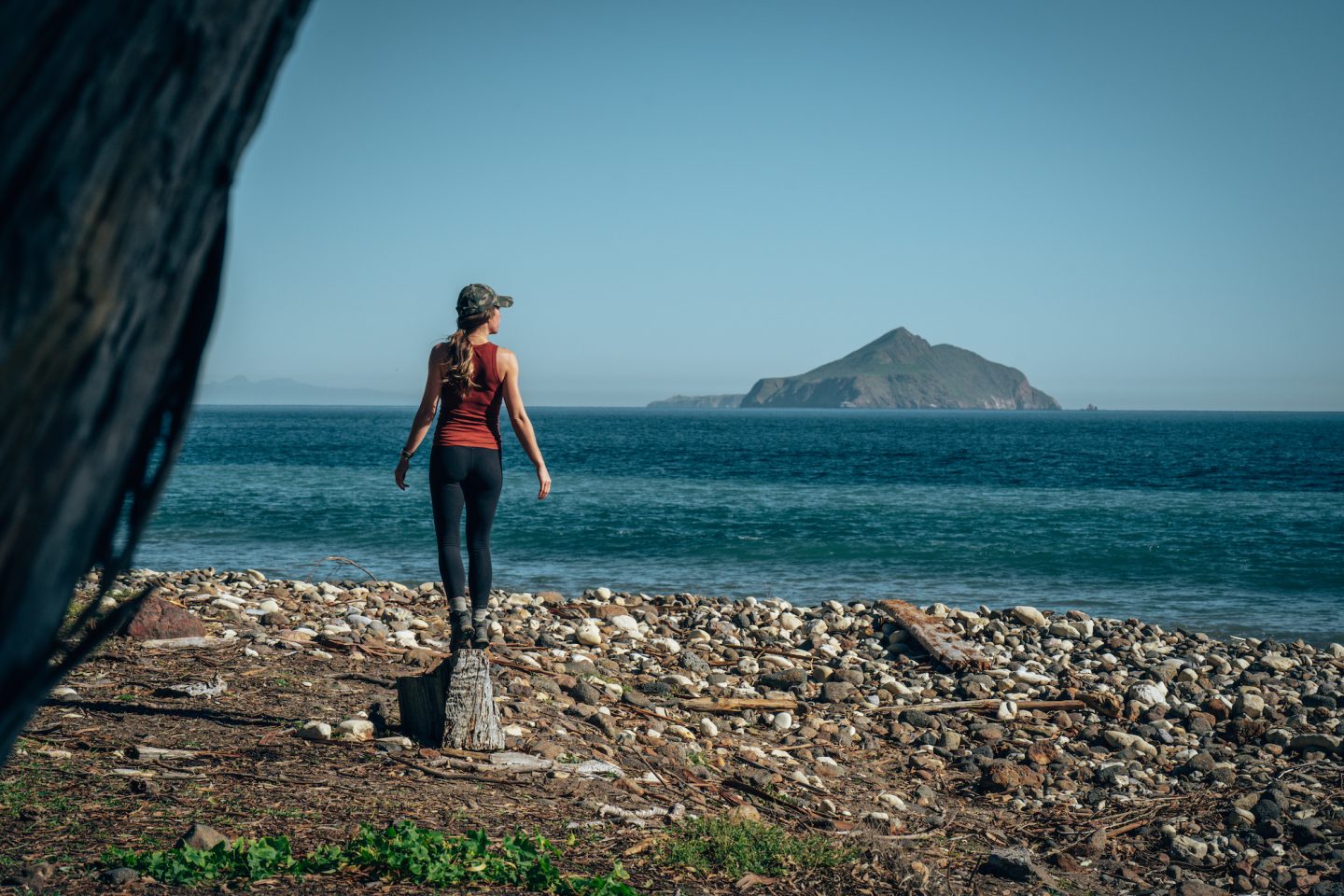
SEASONALITY
Located off the coast of Santa Barbara, Santa Cruz Island, one of the Channel Islands in California, experiences a mild Mediterranean climate due to its coastal location. This is one of California’s national park that is great for visiting year-round! Here are approximate average temperatures for each season on Santa Cruz Island:
| SPRING | SUMMER | FALL | WINTER | |
| Average Temps. | H: 70ºF / L: 45ºF (21ºC / 7ºC) | H: 75ºF / L: 55ºF (24ºC / 13ºC) | H: 70ºF / L: 50ºF (21ºC / 10ºC) | H: 65ºF / L: 45ºF (18ºC / 7ºC) |
| RAINFALL (INCHES) | 1-2 | 0-1 | 1-2 | 1-2 |
| SUNRISE/SUNSET | 6:00AM / 7:30PM | 5:30AM / 8:00PM | 7:00AM / 7:00PM | 7:30AM / 5:30PM |
JOSHUA TREE NATIONAL PARK
Joshua Tree National Park is the second-most visited national park in California, with just over 3 million visitors per year. Located just a couple hours’ drive from Los Angeles in southeastern California, this national park is easy to get to and easy to explore! Although there’s plenty to choose from, we’d say that these are the 5 MUST-DO ACTIVITIES IN JOSHUA TREE NATIONAL PARK. With the popularity of this California national park, you’ll want to try to catch sunrises and sunsets since that’s when it’s the least crowded. We also recommend not going in the middle of summer because it gets H-O-T!
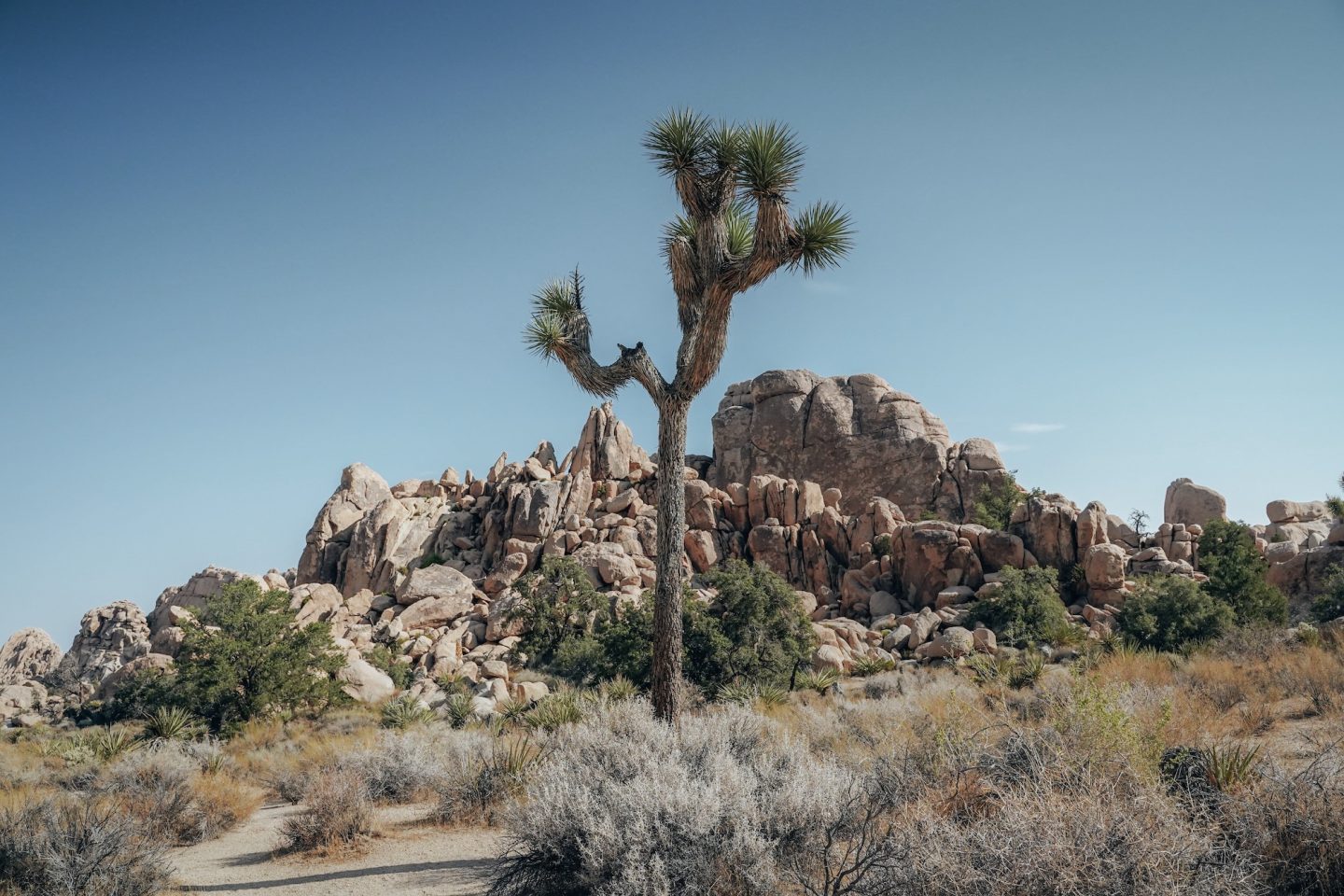
SEASONALITY
Joshua Tree National Park experiences a desert climate with significant temperature variations between day and night. Here are approximate average temperatures for each season within the park:
| SPRING | SUMMER | FALL | WINTER | |
| Average Temps. | H: 90ºF / L: 50ºF (32ºC / 10ºC) | H: 105ºF / L: 70ºF (41ºC / 21ºC) | H: 95ºF / L: 55ºF (35ºC / 13ºC) | H: 70ºF / L: 30ºF (21ºC / -1ºC) |
| RAINFALL (INCHES) | 0.5-1 | 0.1-0.5 | 0.5-1 | 0.5-1 |
| SUNRISE/SUNSET | 6:00AM / 7:30PM | 5:30AM / 8:00PM | 7:00AM / 7:00PM | 7:30AM / 5:30PM |
DEATH VALLEY NATIONAL PARK
With a name like “Death Valley,” it’s hard to imagine just how beautiful and unique this national park is! From the colorful Artists Palette, to the vastness of the Mesquite Flat Sand Dunes, to the lowest point below sea level in the continental U.S. (300 feet!) in Badwater Basin – Death Valley National Park is a must-visit! Get all the planning details at ULTIMATE GUIDE TO DEATH VALLEY NATIONAL PARK!
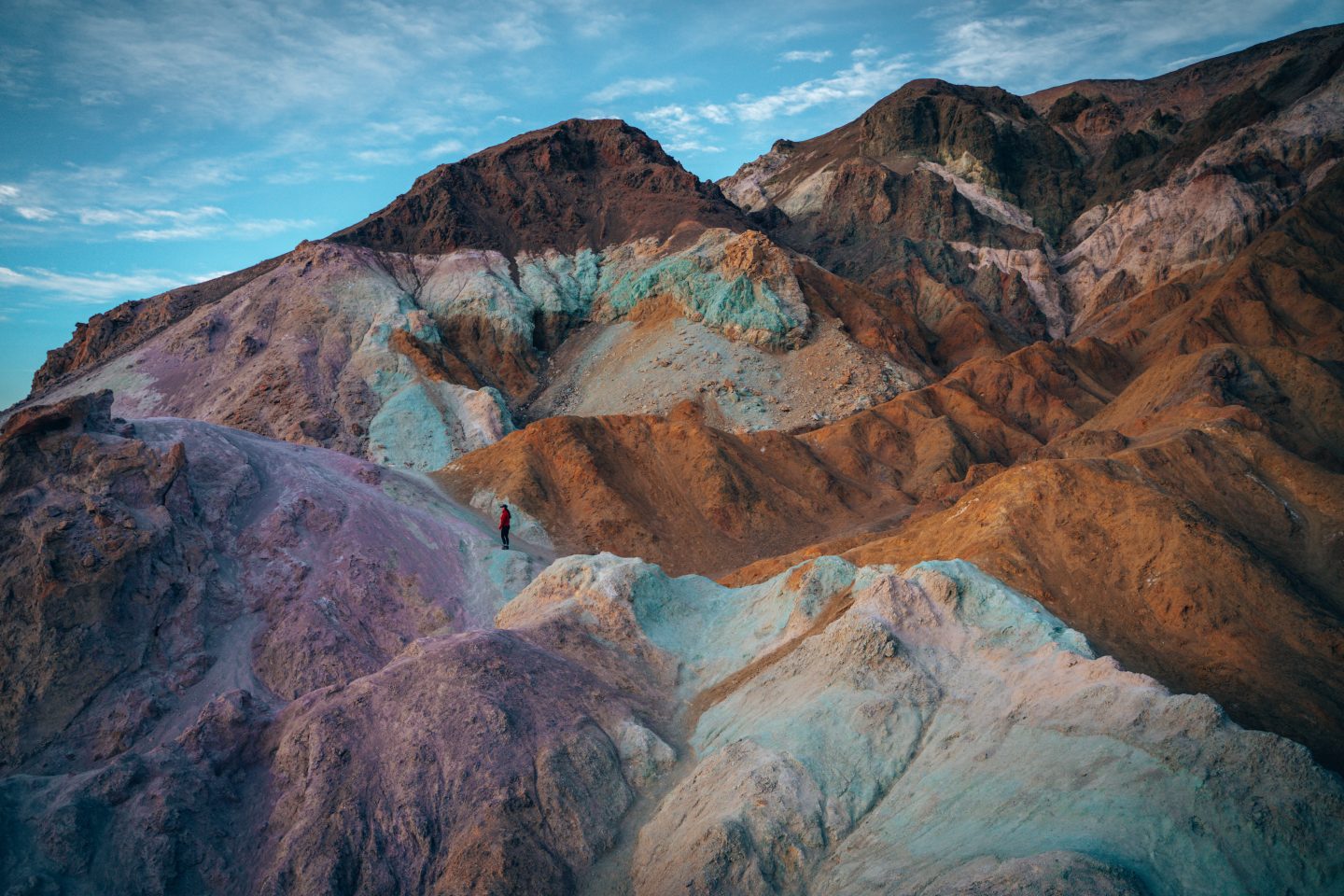
SEASONALITY
Death Valley National Park, situated in the Mojave Desert of California, is known for its extreme desert climate with scorching temperatures. You’ll want to skip this park in the summer as it has a long history of being the hottest and driest place on Earth. Here are approximate average temperatures for each season within the park:
| SPRING | SUMMER | FALL | WINTER | |
| Average Temps. | H: 100ºF / L: 55ºF (38ºC / 13ºC) | H: 120ºF / L: 80ºF (49ºC / 27ºC) | H: 100ºF / L: 60ºF (38ºC / 15ºC) | H: 70ºF / L: 30ºF (21ºC / -1ºC) |
| RAINFALL (INCHES) | 0.1-0.5 | 0 | 0.1-0.5 | 0.1-0.5 |
| SUNRISE/SUNSET | 6:00AM / 7:30PM | 5:30AM / 8:00PM | 7:00AM / 7:00PM | 7:30AM / 5:30PM |
SEQUOIA & KINGS CANYON NATIONAL PARKS
While recognized as two individual national parks, Sequoia and Kings Canyon share a border so they are often visited in the same trip and are lumped together. They even share a home on the NPS website. These are the only two national parks in California that we haven’t visited! That being said, here’s the information we will be using to plan when to visit. Amongst California’s national parks, Sequoia and Kings Canyon fall 3rd and 5th respectively in the number of visitors annually. Summer is the most popular time to visit with the favorable weather and more areas of the park being open without winter road closures.
Because of the extreme elevation range in these parks, weather conditions vary widely between areas. In summer, the sequoia groves have comfortable temperatures and the foothills are hot and dry. Snow lingers on high-mountain passes well into summer. In fall, some areas close or reduce their hours. Winter brings snow to sequoia groves and rain to the foothills. Spring is a great time to hike in the foothills and snow begins to melt at higher elevations.
Check out our HOW TO SPEND ONE DAY IN SEQUOIA NATIONAL PARK to plan an epic trip to this magical park!
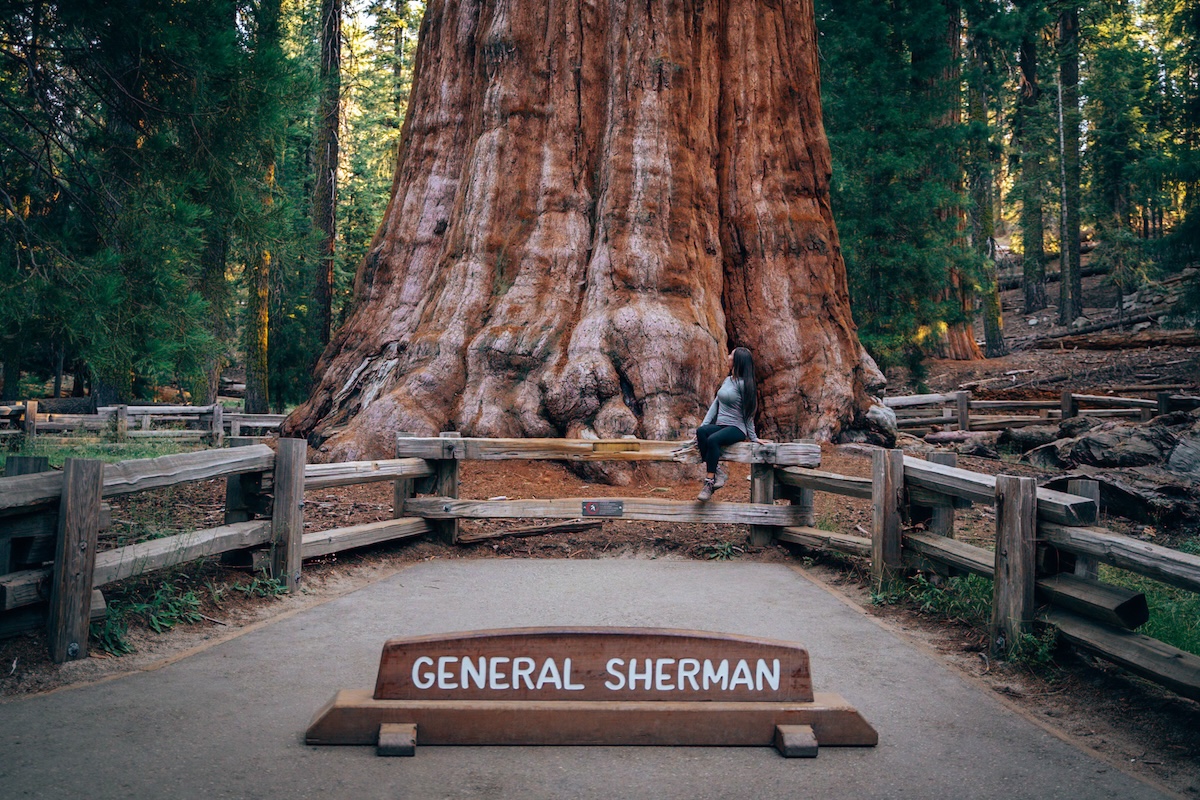
SEASONALITY
| SPRING | SUMMER | FALL | WINTER | |
| Foothills (1,000-3,500 ft.) | H: 70ºF / L: 45ºF (21ºC / 7ºC) | H: 90ºF / L: 60ºF (24ºC / 7ºC) | H: 80ºF / L: 50ºF (27ºC / 10ºC) | H: 50ºF / L: 30ºF (10ºC / -1ºC) |
| Mid-Elevation (3,500-7,000 ft.) | H: 60ºF / L: 35ºF (15ºC / 2ºC) | H: 75ºF / L: 45ºF (18ºC / 2ºC) | H: 65ºF / L: 35ºF (18ºC / 2ºC) | H: 45ºF / L: 20ºF (7ºC / -6ºC) |
| High Sierra (7,000-14,000 ft.) | H: 50ºF / L: 25ºF (10ºC / -4ºC) | H: 65ºF / L: 35ºF (18ºC / 2ºC) | H: 55ºF / L: 25ºF (13ºC / -4ºC) | H: 40ºF / L: 15ºF (4ºC / -9ºC) |
| RAINFALL (INCHES) | 5-10 | 0-5 | 5-10 | 10-15 |
| SNOWFALL (INCHES) | 20-60 | Minimal to none | 5-20 | 150-300 |
| SUNRISE/SUNSET | 6:00AM / 8:00PM | 5:30AM / 9:00PM | 7:00AM / 7:30PM | 7:30AM / 5:30PM |
BEST TIME TO VISIT CALIFORNIA’S NATIONAL PARKS
California’s national parks span 6.3 million acres across the golden state – to say there’s a lot of ground to cover would be an understatement! California’s national parks offer an unrivaled diversity of environments, from lush forests and roaring waterfalls to stark deserts and volcanic landscapes. So, whether you’re an avid hiker, a wildlife enthusiast, or simply in search of jaw-dropping views, California’s national parks provide a canvas of natural wonders waiting to be explored!
EXPLORE CALIFORNIA LIKE NEVER BEFORE
While this article touches on some of the best times to visit California’s national parks, there is still a TON of information that we simply could not pack in to a single article. That’s where our epic interactive map of California comes in handy. Within this map and guide, we will find over 270 points of interest with detailed information about each location, cost, seasonality, dog-friendliness, and much much more! It also answers the question of, “what is there to do in each place?” Not much of a planner? No worries! We also have curated itineraries to make the planning process easier for you. And if that isn’t enough, book a call with us or have us create a custom itinerary for you! We are here to help!
